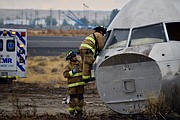Keeping prepared
MOSES LAKE — Flames billowed and smoke rose from an old van hooked up to a giant propane tank more than 100 feet away.
Fire crews from the Port of Moses Lake Fire Department as well as Grant County Fire District 5 responded, attacking the burning wreck near the main runway with high-powered hoses from a distance.
Had this been a real crash, it wouldn’t have been the van on fire. It would have been the field, and the hulk of airplane fuselage lying in the middle of a blackened patch of sagebrush.
It was all a drill, of course, to test the airport’s readiness to handle a disaster. That’s especialy important since regular activity at Grant County International Airport now involves constant testing of Mitsubishi’s regional jet. (MRJ).
“We’re going to essentially have a crash out on the airfield today,” said Richard Mueller, director of facilities and operations for the Port of Moses Lake.
The exercise was many months in the planning, and involved not just the Port and its fire and security contractors, but the Grant County Sheriff’s Department, Samaritan Hospital, the Grant County Health District, AMR Ambulance Service, the coroner’s office, Mitsubishi, and even the Soup Ladies, who serve meals to witnesses, survivors and first responders at disasters sites across the country.
The exercise came in two parts. First, a “regional jet” — played by Mitsubishi’s MRJ — had a hydraulic failure upon landing that resulted in a blown-out tire and two injured crew members. Fire crews responded quickly to the simulation and took two “injured” crew members off in an ambulance. Mitsubishi crews decided not to change the tire on the MRJ, but merely towed the plane back to the hangar.
Mitsubishi spokesperson Morgan Heysse said the tire wasn’t changed because Mitsubishi already practices that and the change wasn’t an essential part of the port exercise.
“Instead, we were able to concentrate our efforts on the main focus of the drill, which was communication and coordination with the Port, first responders, and the Moses Lake community,” she said.
The second drill — which started an hour late thanks to issues with getting all the injured made up properly and problems getting a van started — involved the crash of a “regional jet” with 30 passengers on board. Volunteers from Big Bend Community College, made up to look either injured or dead, were placed in or near a piece of 757 fuselage while the old van was set alight.
“It’s about learning to work with each other,” Mueller said. “We’re a little bit tighter, a little bit sharper.”
Mueller said later on Friday that the exercise showed some solid strengths in the ability of fire crews and first responders to get to the “crash site” quickly. However, Mueller said the exercise also showed some weaknesses the Port needs to work on.
Security was an issue, Mueller said, and the Port needs to keep better track of who is coming and going and who has access to the tarmac in an emergency. Keeping track of volunteers was also an issue, especially those playing dead and wounded. It didn’t matter so much now, but making sure every body is accounted for in a real disaster is important, Mueller said.
Mueller added the Port also needs a social media strategy and a better way to handle distraught family members, especially if any accident survivors are able to tweet, text, Snapchat or Instagram from a crash site.
“That was not part of the drill, getting information out and monitoring social media,” Mueller said. “It’s something to look at for next time.”
And next time will be three years from now, as required by Federal Aviation Administration rules.
Charles H. Featherstone can be reached via email at countygvt@columbiabasinherald.com.





